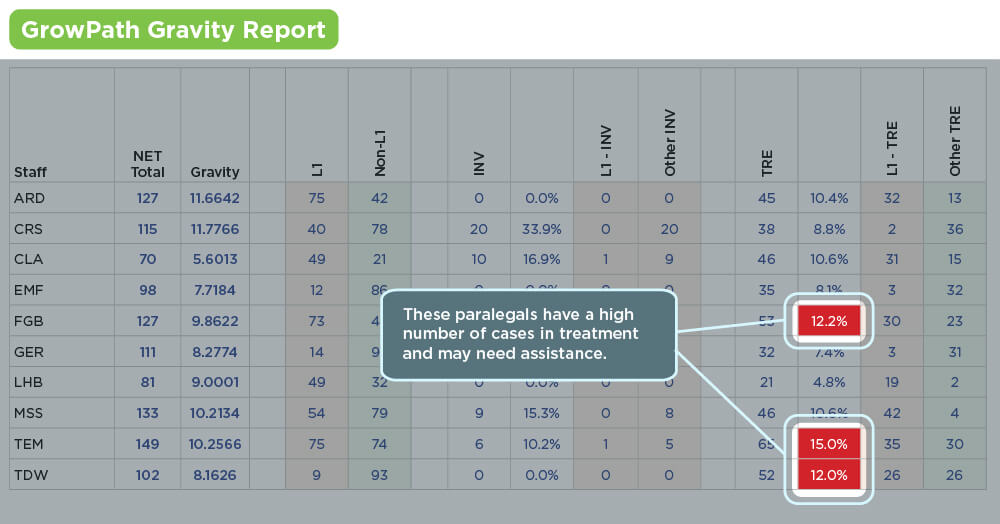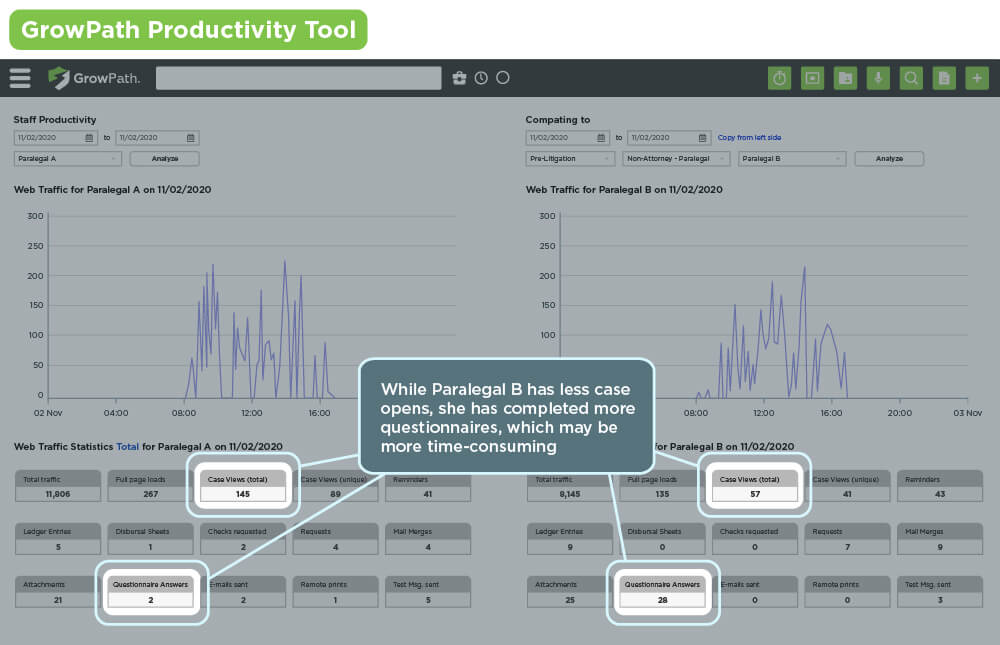How Can You Tell the Difference Between a Good Performer Who Is Overwhelmed and a Poor Performer?

This may seem like a straightforward question, but it’s not. Why? Because the causes of poor performance are not always straightforward. It can be the result of someone who doesn’t have the skills or attitude to perform. Or it can be the result of someone who is being asked to do too much.
Both types of employees are unproductive and can impact your cases. Your job is to identify productivity issues and then dig into the reasons for the subpar performance to determine if it’s a systematic problem that the firm needs to address, or an individual productivity issue.
Be careful not to get caught in the trap of rushing to judgement based on one set of metrics alone, such as the average paralegal caseload at your firm. And once you identify a productivity issue, drill down to determine the causes. Underperforming employees can be incompetent … or overloaded. Some things to consider:
- If you have identified incompetence as the issue, do you need to provide additional training, or is there a lack of interest, drive, or ability?
- If you have identified overload as the issue, do you need to redistribute caseloads, or ensure that the employee has (and is using) tools to manage her caseload?
Each answer leads to a different response, but it will be a response that addresses the real issue. This should lead to improved productivity. And productive employees keep cases moving, which keeps clients happy – both of which drive profit for your firm.
For information on the types of key performance indicators law firms can track to get a handle on staff productivity, get our list of 29 KPIs to Measure Paralegal & Attorney Productivity.
Below I will share with you some key questions to consider when trying to determine the root cause of a productivity issue. In the 30+ years I spent practicing law, I managed high volumes of cases and people and found that asking questions always helped. The answers you uncover should help you get a handle on whether an unproductive employee needs help, a nudge, or a farewell.
Note: For the purpose of this post, I am assuming a very basic personal injury law firm structure – one where the bulk of the work responsibilities shift from the paralegal in the pre-demand phase to the attorney in the post-demand phase. Every firm is different, and you should adjust these questions and answers to accommodate your firm’s structure. While the focus here is on paralegals, the same concepts can (and should) be applied to attorneys and other employees at your firm.
What Kind of Cases Make Up Your Paralegal’s Caseload?
It’s important to have a handle on the composition of paralegals’ caseloads. What types of cases (soft tissue/subjective injury, definitive injury, wrongful death, etc.) are included? Balance this information against your understanding of what time and effort goes into managing each type of case at your firm.
This differs for every firm – some firms have separate teams who handle specific tasks, such as medical records follow-up and referrals, while paralegals in other firms might perform these tasks. Understanding your firm’s expectations by case type will help you determine whether your paralegal has an unbalanced caseload and legitimate reason for being overwhelmed.
Your case management software should also be able to help you here. GrowPath has a gravity report which assigns an algorithmic value to each paralegal’s caseload. This report breaks down the types of cases, as well as the number of cases in specific stages, so that a manager can objectively compare caseloads of all paralegals at a glance and see who might be overwhelmed and who might have capacity.
What Stage of Work Are the Bulk of Your Paralegal’s Cases In?
If you have a paralegal who is underperforming, you can gain additional insight into possible reasons for this by looking at the work stages of the cases.
- If paralegal A has the bulk of his cases in pre-demand, for example, and you have identified a dip in KPIs (he’s behind on client contacts or requests for outstanding records), this could be an indication that he has too many cases in that stage and that he’s having a hard time prioritizing. A manager should step in and provide guidance at this point.
- If paralegal B has the bulk of her cases in post-demand, where the workload responsibilities have shifted to others and she, too, is behind on tasks, it’s possible she’s not capable of doing the job efficiently. Or you might uncover some process or operational issues – perhaps she is performing tasks that are not her responsibility – which might need to be addressed by a process change.
GrowPath’s gravity report breaks down each person’s caseload into what stage they are in (investigative, waiting-on-medical information, treatment, etc.) and highlights high percentages indicating issues that could lead to bottlenecks. Managers can see at a glance where a paralegal may have issues and can step in to see if assistance is needed or if someone is getting careless.

How Does Your Paralegal Stack Up to Others?
Compare your paralegal’s productivity KPIs (client contacts made, intakes opened, case views, ledger entries made, etc.) to:
- other paralegals with similar caseloads
- top-performing paralegals
- paralegal staff’s average
- his/her past performance
How can you track your paralegal’s productivity week-to-week? By measuring and comparing activities that reflect productive action, in addition to time logged on and pages viewed, you will get a clearer picture of individual productivity. This will help you determine whether your paralegal is an underperforming employee who needs additional training, or if your paralegal is an underperformer that needs a nudge, or even a change in work duties.
GrowPath’s Productivity Tool quickly compares paralegal performance in a specific timeframe, as well as across timeframes. It also provides immediate insights on key performance indicators and gives you an instant snapshot of when a paralegal is working and what tasks are being done. How can you track your paralegal team’s production levels? GrowPath’s Matter Trackers allows you to track matters by department and obtain a high level view of your team’s caseload and performance in real-time on one screen.

Is Your Paralegal Taking Advantage of Available Tools?
Underperformers, whether they are overwhelmed or uninspired, often spend time on unnecessary tasks. Typical time-wasting activities include creating new spreadsheets and documents when templates exist or developing personal systems rather than utilizing established ones. Another common time-waster is the constant creation, and revision, of to do lists. As a manager, you want to be sure to provide the tools and systems your paralegals need to successfully perform their jobs, and then you want to confirm that they are using them.
Your case management software should be able to help here also. GrowPath is populated with easy-to-access templates for spreadsheets and documents so there is no need for a paralegal to start from scratch. Our platform also updates tasks and reminders in real-time, and to do lists are automatically updated with the items that need the most attention.
A Word About Caseload Assignments
As we’ve established, not all cases are equal. A caseload of 200 cases can be very different in terms of the time and effort required to manage it than a different caseload of the same number. When assigning new cases (or reassigning cases when someone leaves), it is important to not fall into the all-too-easy trap of assigning additional cases to the paralegal with the least number of cases. While that paralegal could have less cases because she’s uber-efficient and has transitioned her cases quickly, she could also be a struggling underperformer who needs more assistance. Check the age of cases within caseloads as well, since new cases are often more time intensive. Take the time to use the data in your case management system to determine who really can handle the extra cases so that you do not inadvertently throw an anchor to a drowning paralegal.
So always dig deep and ask the questions that will help you figure out whether your underperformers are unable or overwhelmed. Then dig a little deeper so you can determine how best to help.